| |
|
(1) Goals
and Missions |
|
Education is a studying process to
develop the potentials of the students
and to train the students to adapt to
and improve the living environment.
Cyberfair activity has promoted the
healthy growth of each team members, it
is also a practice to train the Grade
1-9 Curriculum logos. Since we have
fixed the subject, the tutors, community
fellows and student volunteers have born
the holy mission to uncover the
mysterious Truku Weaving Culture, this
whole process is the combination of the
elder's wisdom, the documentary of the
specialists, the school community and
the information technology.
|
|
(2) Content
of Education |
|
After I have studied this subject
webpage report, I suddenly realized that
the Grade 1-9 Curriculum education
content is exactly the experience of our
teams. And I would explain it briefly in
the following part.
1) Humanistic aspect:
The team members should first recognize
their own abilities and then respect and
appreciate the characters of other
people as well as the differences
culture among different age groups.
2) Systematization
ability aspect:
Break the current classroom studying
model, and bring the students to the
community, we do not want the solemn,
standard and cracked knowledge as well
as the rote learning, we need the
reasonable and perceptual attitude,
activities combined theory and practice
as well as humanities.
3) People's
livelihood aspect:
We have improved our self-expression and
communication ability; we have educated
the students to write down the interview
record and upload their learning through
independent thinking; everyone does his
best through division of labor and
cooperation; everyone works on passing
down of culture, and takes an active
part in socio-culture activity; form law
abiding habitat through the recognition
of intellectual property.
4) Local and
international consciousness aspect:
We have created the local
characteristics and established the
patriotism to protect the environment
through the plant of ramie and the
collect of ramie yarn raw material as
well as the dyeing, this could be shared
with the whole world.
5) Learning all
one's life aspect:
In the interview and record process, we
have gradually learnt how to search for
the data initiatively, how to arrange
the data, how to raise question and how
to solve the question, through the
combination of information media and
language, we have endowed our study
achievement with the reserving and
continued value. |
|
(3)
Information Technology |
|
Tools used |
Purposes |
|
(1)
Telephone |
Communicating instrument to get
in touch with team members and
the respondents before interview
|
|
(2)
Television |
Enjoy public television “Follow
Me” – Making Ramie Cloty,
Scraping Fun, and film about the
Wanrong Township folk-custom
craft activity achievements in
2006 |
|
(3)
Camcorder and digital camera
|
Record the community interview
and observe the growth of ramie
|
|
(4)
Scanner |
Instruments for student works
and reference books and pictures
|
|
(5) Record
pen |
The import instrument to record
the entire dictation of
respondents and it is also the
bases for us to sort out the
literal record of the interview
|
|
(6)
Computer software |
FrontPage
2003, PhotoImpact 8,
EasyPHP+XoopsServer
, ACDseePicture
management ,
Midi manufacture
software, CDex music convert to
files software |
|
(7) Books,
periodical articles
|
The reference books about ramie
or Truku weaving culture, and
the research papers provided by
the respondents. |
|
(8) Field
interview |
Interview the old respondents in
person and record their
dictation data |
|
|
(4) Native Ambassador |
When the school public addressor has
broadcasted that "All team members
should come to the office or
Computer Room," the children are
full of self-confidence and pride.
Our teachers have taught the team
members some courses which are
different from other schoolmates, we
have learnt many interview skills
and information product operation
skills through these courses. We
have interviewed the elder, the
householders and the scholars of the
community during the community
interview. When the respondents have
seen our earnest attitude, they
would try their best to give us the
answer, some of them have prepared
the drinking and biscuits for us,
and some have prepared the
traditional pork blood soup, some
have given us the beautiful handmade
cellular phone bag and the
pachyrhizus of modified race, these
interviews have given us many sweet
memories.
What impressed me most is the
"language" communication, many elder
cannot speak Chinese, when we ask
questions in Chinese, they do not
know how to answer, and we could
only understand their words through
the teacher's translation; and the
respondents have used many tribe
names when we ask them about the
origins of the ancestors, at first
we phoneticize these words, and
gradually we have learnt to use
Roman alphabet, although it is not
very standard, we could still ask
the teachers for help.
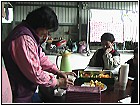 |
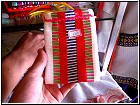 |
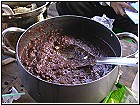 |
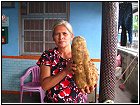 |
|
Mrs. Hu entertains us |
Grandmap Yiyanghas
given us
a cellular phone bag |
Gariyi provides
pork blood soup |
Pachyrhizus given
by Iyan•Uming |
|
|
(5) Impacts |
|
First of all, the team members have
viewed this project through their own
angle, they have learnt a lot in very
short time. Some classmates would ask
them what exactly are they doing, at
first they would say that they are
learning some computer skills, but in
the end they do not say so, they have
gone to many places and have interviewed
many people and have written many
learning and have used different kinds
of latest information equipments, they
could only say that they are very glad
to take part in this meaningful
activity.
Since we have visited Mrs. A-hsueh Liang
Li, the school principal as well as the
proprietor and the chairman of the
community, we have moved them by our
movement. Mrs. A-hsueh Liang Li have
donated 150 ramie roots and we have
strived for our land to plant ramie in
the community, after our laborious
weeding and digging, the ramie
germinates, I feel very glad we could
pass down the ramie weaving culture.
Our teacher have always said to us: "In
the future, when ramie grows up, we must
invite the community elder to teach us
weaving cultural course." Although the
harvest of ramie would still cost us a
lot of time and energy, however as the
members of New Aspen Culture Association
and the pioneers to pass down culture,
we would continue this activity. Only
the community and school interact with
each other, could we reserve the local
culture.
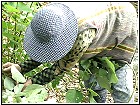 |
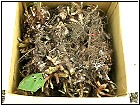 |
 |
 |
|
Yuyuh collect ramie roots
|
Yuyuh has given
a box of ramie roots |
Interview
Mr. Guang-nan He and he
has agreed to lend us the
land |
Plant ramie in the school
|
|
|
(6) Intellectual
Properties |
|
Once we have
finished an interview, we would work
hard on writing down our own learning.
Although it is only a short essay, I
think it is not easy to record the
interview fully. I recalled once two of
the team members have copied the
learning report of one team member, the
next day we were criticized by our
teachers, and they have also explained
the intellectual property to help us
recognize the significance of
intellectual property. Later on we
become very careful when we have to
quote, we would give clear explanatory
notes for all the quoted content, such
as the words, photos, illustrations,
music, films and cartoons. To respect
the data that the respondents have
authorized, we would attach the
documentary sources and letter of
authorization. |
|
(7)
Discoveries, Lessons and Surprises |
Many
people would hold out until the last
for their ideals, such as the
tradition weaving elder we have
interviewed, Mrs. Ching-hsiang Hu in
charge of music collection and
master Gariyi•Jihoh of Institute of
Anthropology. They have a collective
character, which is
to stick to
what one wants to do without any
regret.
When we
interview them, we have seen their
awe to the ancestors, their
self-confidence, their nerves and
professional attitudes which cannot
be seen in every-day life. They have
possessed the energy of knowledge,
which have encouraged us to move
forward. And
the only regret
is that we should study
time control
and improve our
communication ability using tribe
language.
|
|
|